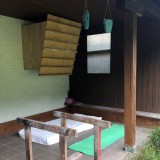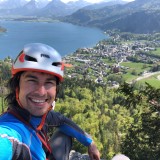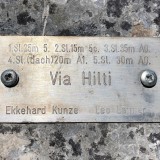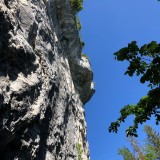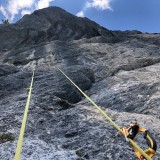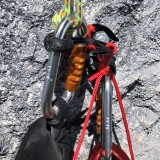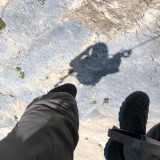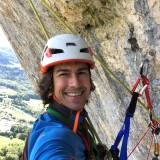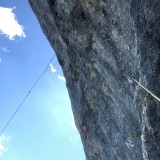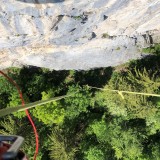During the lock down period
17.03.2020-22.04.2020 - We spend the first weeks of the lock down in Nebelberg. Although I go for a walk every day and do my physiotherapy exercises, I miss the exhausting physical activity. Barbara keeps herself fit with running and tabata training. The clothes pole is used for pull-ups. Lots of office work, which has been neglected for the last weeks, months and years, is worked off. Furthermore, the available equipment for climbing, mountaineering, kite surfing etc. is inspected and sorted.
In mid-April I set off towards Fuschl am See. The injury lay-off and the subsequent inaction in Nebelberg cost me a lot of strength and endurance. Now the time has come to counteract this loss. The first task is building a campus board and setting up a small training site.
Due to the stress on the fingers, it is not advisable to start training on the campus board after a break from an injury. I usually start with a strength endurance training in the climbing gym for at least six weeks before I start with the maximum strength training on the campus board. Unfortunately, this is currently not possible. Therefore, I decide to limit myself at least to hypertrophy training. Even before the first training session I know that it will end with a disillusionment. There is not enough strength endurance. The training intensity can only be increased slowly, but at least it is going upwards.
Solo, but with rope
23.04.2020-23.05.2020 - A climbing technique, which I have wanted to learn for quite a while, is solo lead climbing with a rope. This technique is not trivial and you should know exactly what you are getting into. A suitable belay device for this purpose is currently not available. Therefore, climbers usually use a semi-automatic belay device as a base and modify it accordingly. With the help of a manual I get to work and modify my belay device. I limit the modifications to a minimum because I do not want to weaken the construction.
My first rope-solo lead climbing experience takes me to my local climbing mountain, the Plomberg. I choose the route Flipperl (V+, 5 pitches) which I already know inside out. Rope-solo climbing demands full attention when modifying the setup at the belay because you are not tied into the rope. A mistake would have fatal consequences. Furthermore, every pitch has to be climbed twice to collect the gear. This takes time and effort. In order to improve my technique, I use the following weeks to additionally climb the routes Juniperus (V-, 5 pitches) and Filou (VI+, 8 pitches) on the Plomberg and the route Schober-Südgrat (VII or V-/A0, 7 pitches) on the Frauenkopf.
The Via Hilti
27.05.2020 - Now the time has come for a more ambitious project. I already climbed the aid route Via Hilti (5c/A2, 5 pitches) on the Ewigen Wand with a friend in 2015. Back then it was a pleasant trip on a rainy day, but at that time I was also in top form. This time it feels different. For one thing, I am alone in the wall. I have a fairly large amount of gear on my harness and when I am at the belay, I have to pay close attention to which carabiners I attach and detach. Since the route is partly very overhanging, I have to avoid any mistake while rappelling. Otherwise, I would hang freely and would not be able to reach the wall. For another thing, each pitch has to be climbed or jumared a second time. I climb the roof three times (leading, descending, clearing) because I want to avoid swinging out. Climbing such a route solo is much more demanding, both physically and mentally. This day I really earned my dinner with shandy.
Lessons learned
- The first training session after a long break usually ends with a disillusionment.
- Rope-solo lead climbing is not trivial and requires a lot of practice.





